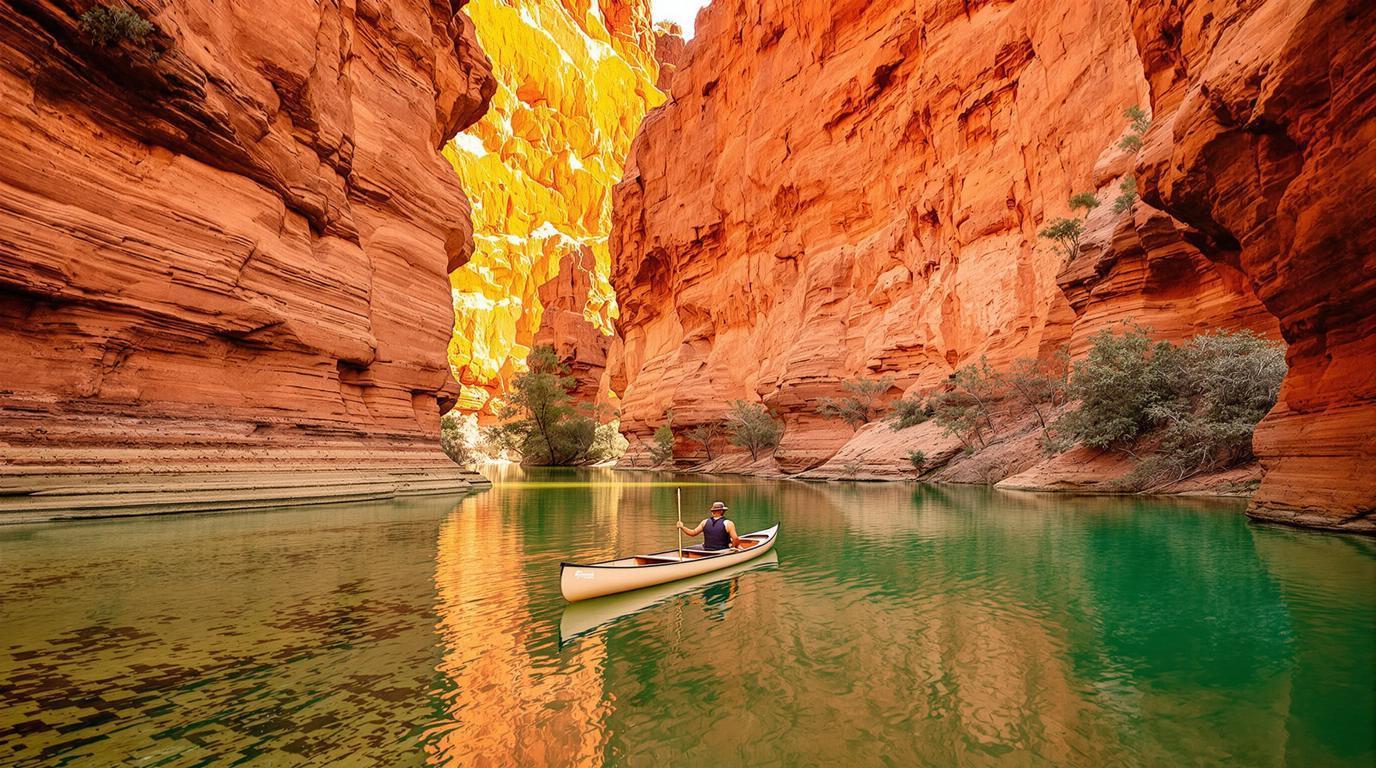Deep in Australia’s Northern Territory, where ancient sandstone walls rise from emerald waters, lies the only gorge system on Earth where Indigenous elders still guide visitors through 40,000-year-old Dreamtime journeys. While tourists flock to overcrowded Kakadu, Nitmiluk National Park remains a sacred sanctuary where Jawoyn people share ancestral wisdom through 13 interconnected gorges carved by the Katherine River.
This isn’t just another pretty landscape—it’s the sole surviving example of continuous Indigenous management spanning four millennia. The Jawoyn Association controls every tour, every story, every sacred site access, creating authentic cultural experiences impossible to replicate elsewhere in Australia.
What makes Nitmiluk absolutely unique becomes clear the moment you slip into a canoe with elder Jimmy Kularr, whose family has navigated these waters since the Dreamtime itself.
The geological wonder that exists nowhere else
Thirteen gorges carved in perfect sequence
Nitmiluk’s 13-tiered gorge system formed over 120 million years through Katherine River’s relentless erosion of 1.65-billion-year-old Kombolgie Sandstone. Unlike scattered gorges found elsewhere, these chambers connect in a single, flowing sequence—each revealing distinct sediment layers that tell Earth’s ancient story through horizontal bands of red, orange, and cream stone.
The cicada dreaming that named this place
In Jawoyn language, “Nitmiluk” means “place of the cicada dreaming”—referencing the creation story where ancestral being Nabilil named the gorge after hearing cicadas sing from the canyon walls. This specific Dreamtime narrative exists nowhere else, making each echo through these chambers a sound heard by 2,000 generations of Jawoyn people.
Cultural experiences unavailable anywhere else in Australia
The Jatbula Trail’s sacred songline journey
The Jatbula Trail follows an ancient Jawoyn songline connecting sacred waypoints—water sources, rock art galleries, and natural temples used for 40,000 years. This isn’t a hiking trail with cultural interpretation; it’s a living ceremonial pathway where elders share knowledge passed down through countless generations, revealing landscape meanings invisible to untrained eyes.
Bolung the rainbow serpent’s protected realm
In the second gorge, Bolung the rainbow serpent still inhabits deep pools that remain off-limits to tourists. Only Jawoyn elders can grant access to these sacred waters, where traditional protocols govern every interaction. This level of spiritual protection and cultural authenticity doesn’t exist in any other Australian national park.
Why Nitmiluk surpasses Australia’s famous alternatives
Kakadu’s crowds versus Nitmiluk’s intimate encounters
While Kakadu hosts massive tour groups through generic “cultural experiences,” Nitmiluk limits visitors to small canoe groups guided by actual community members. You’ll paddle through mirror-calm waters hearing personal family stories, not rehearsed presentations. The difference in authenticity and emotional connection is absolutely profound.
Crocodile encounters in their natural cathedral
Nitmiluk’s saltwater and freshwater crocodiles coexist in a unique gorge ecosystem where towering walls create natural amphitheaters. Unlike other parks where crocodiles feel like dangerous obstacles, here they’re integrated into Dreamtime stories—ancient beings whose presence connects you to Australia’s primordial spirit.
The authentic access that defines true cultural tourism
Jawoyn Association’s exclusive control
Every Nitmiluk tour operates through Jawoyn Association partnerships, with royalties reinvested into community programs. This isn’t Indigenous-themed tourism—it’s Indigenous-owned, Indigenous-led, Indigenous-benefiting travel that creates genuine cultural exchange while preserving sacred traditions for future generations.
Rock art galleries with living interpretations
Ancient rock art sites throughout Nitmiluk come alive through elder-guided interpretations that connect prehistoric images to contemporary Jawoyn life. These aren’t museum exhibits—they’re active cultural sites where traditional knowledge flows between generations, making you witness to humanity’s longest-running cultural conversation.
Nitmiluk National Park stands alone as Australia’s only destination where geological wonder meets unbroken Indigenous stewardship. While other parks offer cultural programs, only here do Jawoyn elders share 40,000-year-old wisdom through landscapes their ancestors created in the Dreamtime.
Book your guided experience through the Jawoyn Association to ensure authentic cultural exchange that honors both your curiosity and their sacred responsibility as guardians of this irreplaceable Australian treasure.
Essential planning for your Nitmiluk journey
When should I visit Nitmiluk for the best cultural experiences?
The dry season (April-October) offers optimal conditions for canoe tours and the Jatbula Trail, when water levels allow safe access to all 13 gorges and rock art sites are easily accessible.
How do I ensure my visit supports the Jawoyn community?
Book directly through Jawoyn Association-approved operators who reinvest profits into community programs, education, and cultural preservation initiatives that strengthen Indigenous self-determination.
What makes Nitmiluk’s cultural tours different from other Indigenous experiences?
Unlike interpreted cultural programs, Nitmiluk offers direct knowledge sharing from elders whose families have managed these lands for millennia, creating authentic cultural exchange rather than performance-based tourism.
Can I explore Nitmiluk independently or are guided tours required?
While some areas allow independent exploration, the most sacred and significant sites require elder-guided access to ensure cultural protocols are respected and traditional knowledge is properly shared.
How does Nitmiluk’s wildlife experience compare to other NT parks?
Nitmiluk’s gorge-dwelling crocodiles exist in a unique ecosystem where towering walls create natural amphitheaters, offering more intimate wildlife encounters than open wetland parks like Kakadu.
